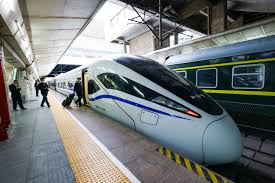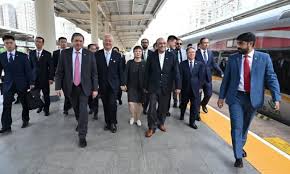High-Speed Rail Now Connects Hong Kong to 93 Mainland Cities, Including Direct Routes from Luoyang

Da Kung Zhongyuan
Zhengzhou: Starting January 5, the national railway system has implemented a new train schedule, significantly expanding the number of mainland cities directly connected to Hong Kong via high-speed rail. The number of railway stations with high-speed train services to Hong Kong has increased to 93, with cultural and economic hubs such as Xi’an, Wuhan, Luoyang, Suzhou, Hangzhou, and Huangshan now offering direct routes to Hong Kong’s West Kowloon Station. The Greater Bay Area has nearly achieved “metro-level” integration through high-speed rail.
This enhanced integration into the national high-speed rail network not only provides travelers with greater convenience but also enriches the multi-layered transportation system and fosters stronger exchanges in trade, culture, and tourism between Hong Kong and the mainland.
On January 5, the first direct high-speed train connecting Xi’an to Hong Kong departed, symbolizing a major milestone in the network’s expansion. The extended G828/G825 train route now links Xi’an North Station and Luoyang to Hong Kong’s West Kowloon Station, reducing travel times to just 10 hours and 5 minutes from Xi’an and 8 hours and 36 minutes from Luoyang. This marks a dramatic reduction in the time and effort previously required for such journeys.
Similarly, at 4:03 PM on the same day, Wuhan’s first direct high-speed train to Hong Kong departed. The G885 “Fuxing” train completed the journey in only 4 hours and 33 minutes, initiating regular high-speed rail connections between the two cities. The route links key urban clusters, including the Wuhan Metropolitan Circle, Changsha-Zhuzhou-Xiangtan Urban Cluster, and the Greater Bay Area. With tickets priced at an affordable 768 RMB, the rail journey offers a more cost-effective alternative to air travel, which typically costs over 1,000 RMB.
In the Yangtze River Delta, the opening of the Shanghai-Suzhou-Huzhou High-Speed Rail (Huzhou-Hangzhou section) has further enhanced connectivity. The Shanghai Hongqiao-Hong Kong West Kowloon G99/G100 train route now runs via the new high-speed rail lines, stopping at Nanchang East, Suzhou South, Hangzhou West, and Huangshan North. Travelers from these cities can now directly reach Hong Kong by high-speed rail.
Compared to the overnight sleeper train that used to operate between Hangzhou East and Hong Kong, the new high-speed train is significantly faster. Departures from Suzhou South and Hangzhou West Stations now take only 7.5 and 6.5 hours, respectively, to reach Hong Kong, cutting travel time by about three hours. Additionally, while the sleeper train only operated from Friday to Monday, the high-speed train runs daily, offering more flexibility for travelers.
“I can explore the Liangzhu Ancient City near Hangzhou West Station in the morning, board the high-speed train, and arrive in Hong Kong in under seven hours, just in time to enjoy the night view of Victoria Harbour,” said one Hangzhou resident, praising the convenience of the new service. To further assist travelers, Hangzhou West Station has even introduced a service center for Hong Kong-Macau travel permits, completing the process in just three minutes.
Since the opening of the Hong Kong section of the Guangzhou-Shenzhen-Hong Kong High-Speed Rail in September 2018, Hong Kong has been seamlessly connected to the mainland’s high-speed rail network. Initially, 44 mainland stations were linked to Hong Kong’s West Kowloon Station. With the latest schedule update, this number has more than doubled to 93, including 22 originating stations for direct routes to Hong Kong. These stations cover major cities such as Beijing, Shanghai, Chongqing, Tianjin, Wuhan, Chengdu, Changsha, Xi’an, Kunming, and Fuzhou, as well as popular tourist destinations like Zhangjiajie and Xiamen.
The inclusion of new connections from cities like Xi’an, Wuhan, Luoyang, Suzhou, Hangzhou, and Huangshan, all major cultural and economic hubs, further enhances the network. In the Greater Bay Area, high-speed rail has achieved near “metro-level” connectivity, enabling seamless travel between cities.
With this expanded network, Hong Kong residents and mainland citizens now enjoy unprecedented convenience for travel and cultural exchange, marking another step forward in Hong Kong’s integration into China’s development blueprint.





